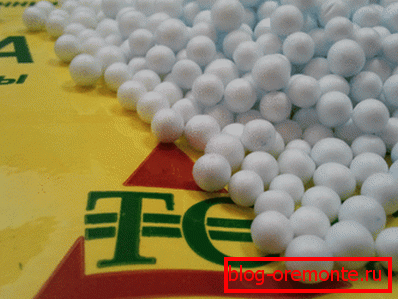We make polystyrene concrete with our own hands:
In this article we will talk about how to make polystyrene concrete with your own hands and what this material is about. Currently, there is a widespread rejection of traditional building materials in favor of fundamentally new technologies.
And this is not surprising, because thanks to progressive construction techniques, you can build buildings and structures that are durable, lightweight, durable and, most importantly, their price will be more affordable!

A typical example is polystyrene concrete - a material created thanks to new technologies and designed to germinate and cheapen individual construction.
Key Features

Light cement-containing solutions, with expanded polystyrene as a filler, have been used for the last 20 plus years. For the construction industry it is a short time, but it is quite enough to determine that the material, if properly used, is strong and durable.
Due to the low level of bulk density of polystyrene foam grains, it is possible to produce lightweight concrete, the bulk weight of which will meet the requirements of a particular application. The operational and technical characteristics of cement-containing solutions with the addition of polystyrene are determined in accordance with GOST R 51263-99.
Despite the fact that you can make high-quality polystyrene concrete floor with your own hands, this material has proven to be an excellent solution for building walls and arranging thermal insulation. Analysis of the cost of cement-containing solutions with different fillers shows that the price of polystyrene concrete is the most affordable.
Advantages with no flaws

Among the distinctive qualities of polystyrene concrete are the following:
- environmental Safety due to the absence of toxins, both during production and during operation;
- durability (over 100 years);
- vapor permeability at the level of wood, which makes this material an excellent solution for the construction of residential premises;
- fire safety due to long-term resistance to the effects of open flame;
- hydrophobicitynot inferior to most traditional building materials;
- increased resistance to low temperatures;
- low thermal conductivity (walls 30-50 cm thick of polystyrene concrete correspond to a brick wall more than 1 meter thick);
- optimum degree of sound insulation;
- no shrinkage, which is especially important when building floor screeds.
Important: Polystyrene concrete is distinguished by ease of machining. Structures made using this material can be drilled, sawed, milled, fastened with nails and self-tapping screws.
Manufacturing technology

The instruction for the production of lightweight concrete with the addition of polystyrene is no more difficult than the manufacture of other types of cement-containing solutions. You will be able to cope with such a task yourself directly at the construction site.
The solution that we have to prepare, is a composite material, that is, it consists of a number of different components, including:
- portland cement;
- silica aggregates (fly ash and / or quartz sand);
- porous aggregate (polystyrene foam);
- modifying fillers (plasticizers and accelerators setting).
Concrete production with the addition of polystyrene is reduced to thorough and uniform mixing of the listed components with a certain amount of water.
The finished solution can be used in two ways:
- the mixture can be poured into special forms and thus wall blocks will be obtained;
- the mixture can be poured into collapsible or fixed formwork directly on the construction site.
Important: The preparation of polystyrene concrete does not require the use of specialized equipment, it will be sufficient to use an ordinary mixer with forced mixing, the price of which is low.
Preparing polystyrene concrete

So, the mixer was purchased or rented, it remains to get down to work.
The sequence of loading the ingredients into the working mixer is as follows:
- we fall asleep the amount of PVG (volume polystyrene granulated foamed polystyrene) and chemical additives in accordance with the recipe;
- then water is added;
- after 2-3 minutes of mixing, pour the cement, and then mix another 3 minutes.
Total, the preparation of the solution takes about 5-6 minutes. At the exit, we must get a continuous porous homogeneous mixture.
Important: Despite the fact that most of the properties of the finished material is determined by the content of polystyrene, the strength depends on water. Adding water beyond measure will most likely lead to a decrease in the strength properties of the finished polystyrene concrete. Water shortage is also unacceptable, as it will lead to increased cracking.
The composition of polystyrene concrete

Perhaps the most important part of the article is a description of what proportions of polystyrene concrete with your own hands can be applied and be sure of the high quality of the result obtained.
Proportions (based on 1m?), Tested in real conditions, are as follows:
- D300: 160 kg of cement grade M300, 75 kg of artificial sand, 9 kg of polystyrene, 5 kg of latex, 95 liters of water;
- D400: 190 kg of cement grade M300, 110 kg of artificial sand, 10 kg of polystyrene, 4 kg of latex, 115 liters of water;
- D500: 215 kg of cement grade M300, 180 kg of artificial sand, 11 kg of polystyrene, 5 kg of latex, 130 liters of water.
Важно: Прочность и durability конструкций, изготовленных с применением полистиролбетона можно существенно увеличить за счет добавления в смесь армирующих волокон, совместимых с портландцементом. Наличие армирующих волокон в затвердевшем материале минимизирует число микродеформаций, спровоцированных растягивающей усадкой и температурными колебаниями в процессе застывания смеси.
Conclusion
So, we figured out what building material can be considered optimal, both in terms of characteristics and in terms of cooking in the living conditions. Moreover, now you know how to make polystyrene concrete with your own hands and to use it as intended.
You can find more useful and informative information by watching the video in this article.